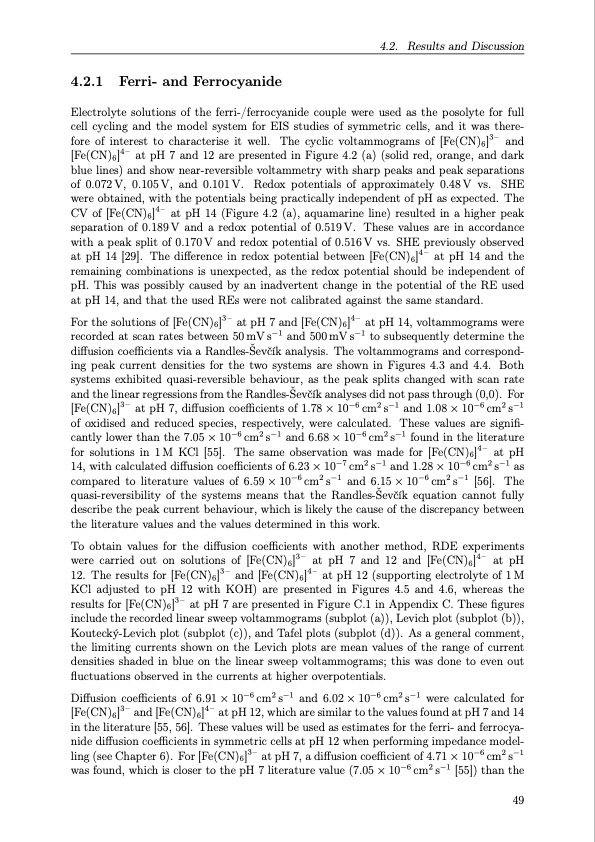
PDF Publication Title:
Text from PDF Page: 070
4.2.1 Ferri- and Ferrocyanide Electrolyte solutions of the ferri-/ferrocyanide couple were used as the posolyte for full cell cycling and the model system for EIS studies of symmetric cells, and it was there- fore of interest to characterise it well. The cyclic voltammograms of [Fe(CN)6]3– and [Fe(CN)6]4– at pH 7 and 12 are presented in Figure 4.2 (a) (solid red, orange, and dark blue lines) and show near-reversible voltammetry with sharp peaks and peak separations of 0.072 V, 0.105 V, and 0.101 V. Redox potentials of approximately 0.48 V vs. SHE were obtained, with the potentials being practically independent of pH as expected. The CV of [Fe(CN)6]4– at pH 14 (Figure 4.2 (a), aquamarine line) resulted in a higher peak separation of 0.189V and a redox potential of 0.519V. These values are in accordance with a peak split of 0.170 V and redox potential of 0.516 V vs. SHE previously observed at pH 14 [29]. The difference in redox potential between [Fe(CN)6]4– at pH 14 and the remaining combinations is unexpected, as the redox potential should be independent of pH. This was possibly caused by an inadvertent change in the potential of the RE used at pH 14, and that the used REs were not calibrated against the same standard. For the solutions of [Fe(CN)6]3– at pH 7 and [Fe(CN)6]4– at pH 14, voltammograms were recorded at scan rates between 50 mV s−1 and 500 mV s−1 to subsequently determine the diffusion coefficients via a Randles-Ševčík analysis. The voltammograms and correspond- ing peak current densities for the two systems are shown in Figures 4.3 and 4.4. Both systems exhibited quasi-reversible behaviour, as the peak splits changed with scan rate and the linear regressions from the Randles-Ševčík analyses did not pass through (0,0). For [Fe(CN)6]3 – at pH 7, diffusion coefficients of 1.78 × 10−6 cm2 s−1 and 1.08 × 10−6 cm2 s−1 of oxidised and reduced species, respectively, were calculated. These values are signifi- cantly lower than the 7.05 × 10−6 cm2 s−1 and 6.68 × 10−6 cm2 s−1 found in the literature for solutions in 1 M KCl [55]. The same observation was made for [Fe(CN)6 ]4 – at pH 14, with calculated diffusion coefficients of 6.23 × 10−7 cm2 s−1 and 1.28 × 10−6 cm2 s−1 as compared to literature values of 6.59 × 10−6 cm2 s−1 and 6.15 × 10−6 cm2 s−1 [56]. The quasi-reversibility of the systems means that the Randles-Ševčík equation cannot fully describe the peak current behaviour, which is likely the cause of the discrepancy between the literature values and the values determined in this work. To obtain values for the diffusion coefficients with another method, RDE experiments were carried out on solutions of [Fe(CN)6]3– at pH 7 and 12 and [Fe(CN)6]4– at pH 12. The results for [Fe(CN)6]3– and [Fe(CN)6]4– at pH 12 (supporting electrolyte of 1M KCl adjusted to pH 12 with KOH) are presented in Figures 4.5 and 4.6, whereas the results for [Fe(CN)6]3– at pH 7 are presented in Figure C.1 in Appendix C. These figures include the recorded linear sweep voltammograms (subplot (a)), Levich plot (subplot (b)), Koutecký-Levich plot (subplot (c)), and Tafel plots (subplot (d)). As a general comment, the limiting currents shown on the Levich plots are mean values of the range of current densities shaded in blue on the linear sweep voltammograms; this was done to even out fluctuations observed in the currents at higher overpotentials. Diffusion coefficients of 6.91 × 10−6 cm2 s−1 and 6.02 × 10−6 cm2 s−1 were calculated for [Fe(CN)6]3– and [Fe(CN)6]4– at pH 12, which are similar to the values found at pH 7 and 14 in the literature [55, 56]. These values will be used as estimates for the ferri- and ferrocya- nide diffusion coefficients in symmetric cells at pH 12 when performing impedance model- ling (see Chapter 6). For [Fe(CN)6]3 – at pH 7, a diffusion coefficient of 4.71 × 10−6 cm2 s−1 was found, which is closer to the pH 7 literature value (7.05 × 10−6 cm2 s−1 [55]) than the 4.2. Results and Discussion 49PDF Image | Organic Redox Flow Batteries 2023

PDF Search Title:
Organic Redox Flow Batteries 2023Original File Name Searched:
PhD_thesis_final_dorhoff_4_.pdfDIY PDF Search: Google It | Yahoo | Bing
Salgenx Redox Flow Battery Technology: Salt water flow battery technology with low cost and great energy density that can be used for power storage and thermal storage. Let us de-risk your production using our license. Our aqueous flow battery is less cost than Tesla Megapack and available faster. Redox flow battery. No membrane needed like with Vanadium, or Bromine. Salgenx flow battery
| CONTACT TEL: 608-238-6001 Email: greg@salgenx.com | RSS | AMP |